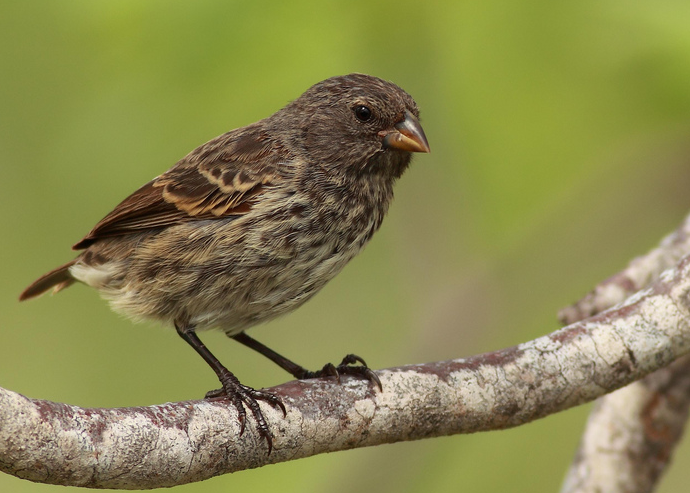Darwin's finches have reached their limits on the Galápagos

The evolution of birds on the Galápagos Islands, the cradle of Darwin’s theory of evolution, is a two-speed process. Most bird species are still diversifying, while the famous Darwin’s finches have already reached an equilibrium, in which new species can only appear when an existing one becomes extinct. This finding expands the classical theory on island evolution put forward in the 1960s. The study of researchers of the University Potsdam, University Edingburgh and the University of Groningen is published online on 23 June 2015 in Ecology Letters.
Islands are seen as natural laboratories for the study of evolution. They form isolated ecosystems with barriers to migration. Classical Island Theory predicts that a dynamic equilibrium will occur between immigration and extinction of species. Recent theory adds that as species diversity increases, ever more ecological niches become occupied, which has a negative effect on immigration (new immigrants from outside of the Galápagos cannot settle) and diversification (radiation into new species is blocked).
DAISIE

‘However, this has never been tested in detail, for lack of data and the right analytical tools’, explains Rampal Etienne, Associate Professor of Theoretical and Evolutionary Community Ecology at the University of Groningen, the Netherlands. Together with Luis Valente (University of Potsdam, Germany) and Albert Phillimore (University of Edinburgh, UK), he developed DAISIE, a mathematical model that uses phylogenetic data on living species to reconstruct evolutionary dynamics. DAISIE stands for Dynamic Assembly of Islands by Speciation, Immigration and Extinction, and was named after famous radiations of daisy-like plants on Hawaii.
Phylogenetic trees
DAISIE was fed with the phylogenetic trees of existing bird species on the Galápagos Islands. These were constructed with genomic data that
Islands saturated
‘The analysis shows that for the finches, diversity does indeed have a negative effect. There is no more room for new species, unless one of the existing species becomes extinct, so the islands are saturated regarding finch-type species’, Etienne explains. This does not mean the radiation is static. ‘We found that the rates of both evolution and extinction are very high for Darwin’s finches. That is probably why these birds have reached an equilibrium.’

Mockingbird
Other species like mockingbirds have not yet reached equilibrium, which contrasts sharply with the current view that oceanic islands are at equilibrium. ‘Our data shows that they are evolving more slowly and are still diversifying.’ In a million years or so, more mockingbird species may have appeared – granted that conditions on the islands remain the same.
Isolated ecosystems
The study shows that the DAISIE model – which the authors have made available as a library* in the free and widely used R software environment – is a valuable tool for the study of evolutionary dynamics on islands. It includes speciation and thus extends existing island theory, which is based on immigration and extinction. Etienne: ‘And of course, it works for all isolated ecosystems, not just islands but also lakes or mountain tops.’
Conservation
Apart from explaining evolutionary history, DAISIE also predicts future diversity. ‘This could be interesting from a conservation point of view: ww are not just conserving existing species, but also future diversity.’
More information
- *Link to the DAISIE programme: http://cran.r-project.org/web/packages/DAISIE/index.html
- Reference: Luis M. Valente1, Albert B. Phillimore2 and Rampal S.Etienne3 Equilibrium and non-equilibrium dynamics simultaneously operate in the Galápagos islands.
Ecology Letters
(2015), doi: 10.1111/ele.12461
1 Unit of Evolutionary Biology/Systematic Zoology, Institute of Biochemistry and Biology, University of Potsdam, Karl-Liebknecht-Strasse 24-25, Haus 26, D-14476 Potsdam, Germany; 2 Institute of Evolutionary Biology, The University of Edinburgh, Edinburgh, EH9 3JT, UK; 3 Groningen Institute for Evolutionary Life Sciences, University of Groningen, PO Box 11103, Groningen 9700 CC, The Netherlands - Contact: Rampal Etienne
More news
-
19 December 2025
Mariano Méndez receives Argentine RAÍCES award
-
18 December 2025
Why innovate, and for whom?
-
17 December 2025
Ben Feringa wins Feynman Prize
